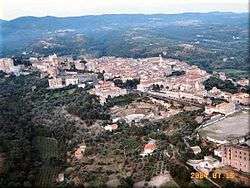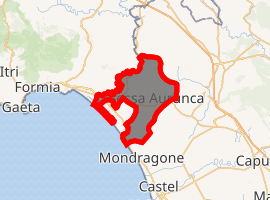Sessa Aurunca
Sessa Aurunca is a town and comune in the province of Caserta, Campania, southern Italy. It located on the south west slope of the extinct volcano of Roccamonfina, 40 kilometres (25 mi) by rail west north west of Caserta and 30 kilometres (19 mi) east of Formia.
Sessa Aurunca | |
|---|---|
| Comune di Sessa Aurunca | |
 | |
 Coat of arms | |
Location of Sessa Aurunca 
| |
 Sessa Aurunca Location of Sessa Aurunca in Italy  Sessa Aurunca Sessa Aurunca (Campania) | |
| Coordinates: 41°14′N 13°56′E | |
| Country | Italy |
| Region | Campania |
| Province | Caserta (CE) |
| Frazioni | Aulpi, Avezzano, Baia Domizia, Carano, Cascano, Cescheto, Corbara, Corigliano, Cupa, Fasani, Fontanaradina, Gusti, Lauro, Li Paoli, Maiano, Marzuli, Piedimonte, Ponte, Rongolise, San Carlo, San Castrese, San Martino, Santa Maria a Valogno, Sorbello, Tuoro, Valogno |
| Government | |
| • Mayor | Silvio Sasso |
| Area | |
| • Total | 163 km2 (63 sq mi) |
| Elevation | 203 m (666 ft) |
| Population (31 December 2017)[2] | |
| • Total | 21,252 |
| • Density | 130/km2 (340/sq mi) |
| Demonym(s) | Sessani |
| Time zone | UTC+1 (CET) |
| • Summer (DST) | UTC+2 (CEST) |
| Postal code | 81037 |
| Dialing code | 0823 |
| Patron saint | St. Leo IX |
| Saint day | May 8 |
| Website | Official website |
It is situated on the site of the ancient Suessa Aurunca, near the river Garigliano. The hill on which Sessa lies is a mass of volcanic tuff.
Toponym
The name Sessa comes from Colonia Julia Felix Classica Suessa (or in short "Suessa"), a city belonging to the ancient Auruncan Pentapolis, which is the historic core of the downtown. It is assumed that the name can be derived from the happy location ("sessio", that is, seat, gentle hill from the mild climate of the local territory).
Physical geography
Sessa Aurunca is the largest municipality in the province of Caserta for territorial extension, the second in Campania after Ariano Irpino. It is located 44 km from the Caserta on the modern SS7, the Via Appia state road.
History
The ancient chief town of the Aurunci, Suessa is sometimes identified with a site at over 600 m above the level of the sea, on the narrow south-western edge of the extinct crater of Roccamonfina. Here some remains of Cyclopean masonry exist; but the area enclosed, about 100 by 50 metres (330 by 160 ft), is too small for anything but a detached fort. This site dates more probably from a time before the wars between the Aurunci and the Romans.
In 337 BC the town was abandoned under the pressure of the Sidicini, in favour of the site of the modern Sessa. The new town kept the old name until 313, when a Latin colony under the name Suessa Aurunca was founded here. It was among the towns that had the right of coinage, and it manufactured carts, baskets and others. Cicero speaks of it as a place of some importance. The triumviri settled some of their veterans here, whence it appears as Colonia Julia Felix Classica Suessa. From inscriptions it appears that Matidia the younger, sister-in-law of Hadrian, had property in the district. It was not on a highroad, but on a branch between the Via Appia at Minturnae and the Via Latina crater mentioned.
Suessa saw its maximum urban expansion in the early Roman imperial age: the town extended over an area almost twice the current and counted several large buildings.
After the fall of the Western Roman Empire, Sessa lost much of its population, and was located on the boundaries between the Duchy of Benevento (later Principality of Capua) and the Duchy of Gaeta. Starting from the 14th century it became a fiefdom (as a semi-independent duchy) of the Marzano family, part of the Kingdom of Naples. In 1466 it returned under direct control of the Neapolitan crown.
Main sights
Ancient era
- Roman Theatre (2nd-1st century BC). Excavated since 2001, it was enlarged by Matidia Minor in the 2nd century AD. It could hold more than 6,500 spectators with a scene of about 40 meters in length and 25 in height. The theater was built on the slope of a hill, facing the Gulf of Gaeta.
- Cryptoporticus (1st century BC)
- Aerarium – Tabularium
- Ronaco Bridge, in brickwork, formed by twenty-one arches

Middle Ages
- Cathedral, a medieval basilica with a vaulted portico and a nave and two aisles. Begun in 1103, internally it features a mosaic pavement in the Cosmatesque style, a good ambo resting on columns and decorated with mosaics showing traces of Moorish influence, a Paschal candle, and an organ gallery. The portal has sculptures with scenes from the life of Saint Peter and Saint Paul.
- Catacombs of S. Casto
- Ducal Castle, built in the 10th century by the Lombard gastald of the city. It was enlarged under Frederick II of Hohenstaufen with a new tower, and modified to also serve as residence in the 15th century by the Marzano family. It a has a quadrangular plan with double mullioned windows dating from the 13th century.
- Cloister of St. Dominic
- The Cappucini's Gate
Modern and contemporary ages
- Seat of St. Matthew
- Church of St. Stephen
- Church of Sant'Agostino
- Church of Sant'Anna
- St. John's Church at Villa
- Church of San Giovanni Square
- Church of the Annunziata
- St. Charles Church
- Church of St. Germano
- Boarding school "Agostino Nifo" built in the 14th century and opened in 1418.
- Sanctuary of Santa Maria della Libera, in the frazione of Carano.
In some streets are memorial stones with inscriptions in honour of Charles V, surmounted by an old crucifix with a mosaic cross.
Culture
Events in the town include:
- The Holy Week at Sessa Aurunca
- Great District Tournament, held between the first and second Sunday of September.
- Carnevale Aurunco
Tourism
Baia Domizia is a small resort town included in the comune of Sessa Aurunca. The village was built since 1964 and is located near the river Garigliano, inside an Italian pine forest and nice volcanic sand beaches. It is a holiday town with 11 kilometres (7 mi) of private beaches. The village offers a superb combination of sea, sand and sightseeing. Baia Domizia gained the status as a main destination of summer tourism on the Litorale Domizio and is one of the best known seaside resorts in Campania Region.
Transportation
Sessa Aurunca is connected by railway to Naples and Rome.
See also
External links
- Purcell, N., R. Talbert, T. Elliott, S. Gillies. "Places: 433132 (Suessa Aurunca)". Pleiades. Retrieved March 8, 2012.CS1 maint: multiple names: authors list (link)
- https://www.visitsessa.com/
![]()
- "Superficie di Comuni Province e Regioni italiane al 9 ottobre 2011". Istat. Retrieved 16 March 2019.
- "Popolazione Residente al 1° Gennaio 2018". Istat. Retrieved 16 March 2019.